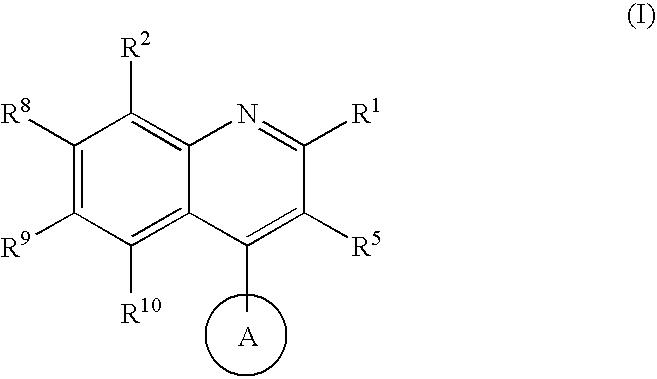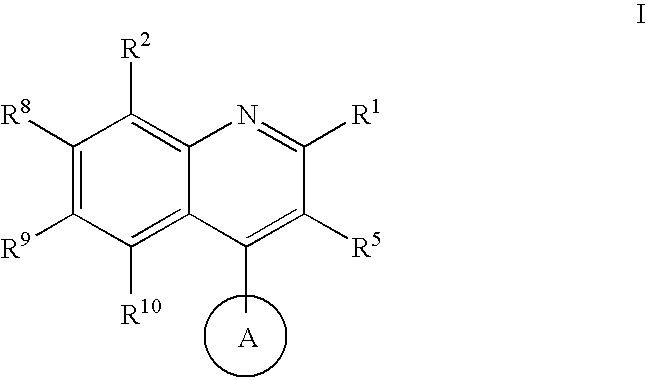Quinoline potassium channel inhibitors
a potassium channel inhibitor and quinoline technology, applied in the field of compounds, can solve the problems of non-selective ksup>+/sup> channel blockers employed in these early studies, unclear physiologic role of particular channels, and limited therapeutic utility of this compound, so as to prevent cardiac arrhythmias and treat them
- Summary
- Abstract
- Description
- Claims
- Application Information
AI Technical Summary
Benefits of technology
Problems solved by technology
Method used
Image
Examples
example 1
2-(Allyloxy)-4-(3-fluorophenyl)-6-methoxyquinoline-3-carbonitrile
[0258]
Step A: (2-Amino-5-methoxyphenyl)(3-fluorophenyl)methanone
[0259]To a 0° C. solution of para-anisidine (8.13 g, 66.0 mmol) in 25 mL of chlorobenzene was added dropwise a solution of BCl3 in dichloromethane (74.3 mL of 1 M, 74.3 mmol). The mixture was stirred at room temperature for one hour, then transferred slowly via syringe to solution of 3-fluorobenzonitrile (4.00 g, 33.0 mmol) and AlCl3 (5.06 g, 37.9 mmol) in 50 mL of chlorobenzene at 60° C. After the addition was complete, the reaction was stirred at 70° C. for 3 hours, then cooled to room temperature and stirred overnight. Water was added (125 mL), and the mixture stirred at 85 degrees for 6 hours. After cooling to room temperature, the mixture was poured into water, and the organic layer was extracted with saturated NaHCO3 solution and brine, dried over Na2SO4, filtered, and concentrated in vacuo. The crude residue was purified by flash chomatography throu...
example 2
(±)-2-(2,3-Dihydroxypropoxy)-4-(3-fluorophenyl)-6-methoxyquinoline-3-carbonitrile, enantiomer A
[0265]
[0266]To a solution of 2-(allyloxy)-4-3-fluorophenyl)-6-methoxyquinoline-3-carbonitrile (140 mg, 0.419 mmol) in 10 mL of tBuOH:THF:water (10:3:1) was added N-methylmorpholine N-oxide (49 mg, 0.42 mmol), followed by a solution of OsO4 (106 mg, 0.42 mmol) in water (ca. 0.5 mL). After stirring for 18 hours, the reaction was diluted with EtOAc, washed with saturated NaHCO3 solution, 10% citric acid solution and brine, and the organic layer was dried over Na2SO4, filtered, and concentrated in vacuo. The crude residue (144 mg) was subjected to preparative chiral HPLC through a Chiralcel OD column (85% hexanes containing 0.1% diethylamine:EtOH). The first eluting peak was collected and concentrated in vacuo to provide the titled product. 1H-NMR (500 MHz, CDCl3) δ 7.81 (d, J=9.0 Hz, 1H), 7.70 (ddd, J=8.1, 8.1, 5.6 Hz, 1H), 7.44 (dd, J=9.0, 2.9 Hz, 1H), 7.30 (ddd, J=8.6, 2.4, 1.0 Hz, 1H), 7.2...
example 3
(±)-2-(2,3-Dihydroxypropoxy)-4-(3-fluorophenyl)-6-methoxyquinoline-3-carbonitrile, enantiomer B
[0267]
[0268]The crude residue from Example 2 was subjected to preparative chiral HPLC through a Chiralcel OJ column (85% hexanes containing 0.1% diethylamine:EtOH). The second eluting peak was collected and concentrated in vacuo to provide the titled product. Proton NMR for the product was consistent with the titled compound. HRMS (ES) exact mass calculated for C20H18FN2O4 (M+H+): 369.1245. Found 369.1239.
PUM
| Property | Measurement | Unit |
|---|---|---|
| temperature | aaaaa | aaaaa |
| temperature | aaaaa | aaaaa |
| temperature | aaaaa | aaaaa |
Abstract
Description
Claims
Application Information
 Login to View More
Login to View More - R&D
- Intellectual Property
- Life Sciences
- Materials
- Tech Scout
- Unparalleled Data Quality
- Higher Quality Content
- 60% Fewer Hallucinations
Browse by: Latest US Patents, China's latest patents, Technical Efficacy Thesaurus, Application Domain, Technology Topic, Popular Technical Reports.
© 2025 PatSnap. All rights reserved.Legal|Privacy policy|Modern Slavery Act Transparency Statement|Sitemap|About US| Contact US: help@patsnap.com



